 For more than two months, the FBI has been rounding up and charging hundreds of Trump-incited insurrectionists who, in hopes of preventing the Congressional certification of Joe Biden's Electoral College victory last November, stormed the U.S. Capitol on January 6th.
For more than two months, the FBI has been rounding up and charging hundreds of Trump-incited insurrectionists who, in hopes of preventing the Congressional certification of Joe Biden's Electoral College victory last November, stormed the U.S. Capitol on January 6th.
But a number of key questions remain wholly unanswered following the unprecedented attack on our very system of representative democracy. Central to several of those questions is Donald Trump's own, personal, behind-the-scenes machinations to help instigate the uprising and, perhaps, prevent the deployment of the military to help quell the rebellion he encouraged.
The March 3rd Senate committee testimony of Major General William Walker, Commander of the D.C. National Guard, describing a seemingly inexplicable delay in authorization for his troops to provide relief to the U.S. Capitol under siege, underscores the need to determine whether there is a connection between Trump's post-election November 2020 purge of the top civilian leadership at the Department of Defense (DoD) and the January 6th assault.
The purge at the Pentagon began two days after media outlets called the Presidential Election for Joe Biden, when Trump fired Secretary of Defense Mark Esper. Within days, four senior DoD officials either resigned or were fired and replaced by what CNN characterized as "conspiracy theorists and Trump loyalists." Christopher Miller became the Acting Secretary of Defense. Kash Patel, who had previously worked for the disgraced Rep. Devin Nunes (R-CA) on the House Intelligence Committee, was appointed to serve as Miller's Chief-of-Staff.
While one Pentagon official described the November purge as "scary", "unsettling" and the moves one would expect from a "dictator", CNN noted in its contemporaneous account that "no one at the Pentagon has an understanding as to what the grand plan is."
Walker's testimony before the Senate Rules and Homeland Security Committees earlier this month, together with other publicly known evidence, points to a distinct likelihood that, once it became clear he couldn't rely upon the U.S. military to carry out a coup, Trump's "grand plan" entailed a stand-down of the D.C. National Guard while his "personal army", an incited mob of white supremacists, stormed the Capitol on January 6...
'Power At All Costs' with Military Coup Unavailable
The January 6 insurrection, according to an analysis proffered by NYU historian Ruth ben Ghiat, was simply the "end game" of Trump's insatiable quest to retain "power at all costs". That analysis was reinforced by the House Impeachment Trial Managers, both by way of their trial brief [PDF] and throughout the course of Trump's second Impeachment Trial, which garnered an historic, bipartisan majority 57-43 vote to convict. Even Minority Leader Mitch McConnell, who voted against conviction on specious "jurisdictional" grounds, acknowledged afterward that Trump was "practically and morally responsible for provoking the events of that day."
The fact that Trump did not order the military to carry out a coup on that fateful day does not mean he didn't give it consideration. The threat that the then Commander-in-Chief might order the military to prevent a peaceful transition of power was regarded as serious enough that Esper, together with every other living, former Secretary of Defense, signed onto on a January 4 Washington Post op-ed. The editorial was specifically directed at Acting Defense Secretary Miller and his subordinates. It contained a stark warning: "Civilian or military officials who carry out [efforts to involve the U.S. military in the election] would be accountable, including facing criminal penalties, for the grave consequence of their actions on our republic."
Last June, Trump had floated the idea of implementing the Insurrection Act of 1807 as an excuse to utilize the military to put down lawful, nationwide Black Lives Matter (BLM) protests. He also activated the D.C. National Guard, which, together with the U.S. Marshall's Service and the Secret Service, launched a vicious and unprovoked assault on peaceful protestors inside Lafayette Square in order to stage his now-infamous bible-toting photo op.
It is likely that, by the time he carried out the November purge at the Pentagon, Trump himself understood that he couldn't rely upon a U.S. military operation to carry out an unlawful coup order.
For starters, during an interview in late January, former Acting SecDef Miller told Vanity Fair's Adam Ciralsky that, last November, when he was appointed by Trump to the position of Acting Secretary of Defense, Trump told him: "No military coup, no major war, and no military troops in the street."
Even if there's reason to question Miller's veracity, there can be no doubt but that the Lafayette Square assault/photo-op was regarded as a "debacle" not only by the media but also within the upper echelons of the U.S. military. The Pentagon pushed back so hard against this misuse of military power afterward, that the Chairman of the Joint Chiefs of Staff, General Mark Milley, who had taken part in the photo op, felt compelled to issue a public apology. "My presence," Milley lamented, "created a perception of the military involved in domestic politics."
Coup by Military Stand-Down?
Assuming Miller's statement to Ciralsky was accurate, Trump's November purge remark, "no military troops in the street", precisely defined the problem faced by the overwhelmed U.S. Capitol Police force on January 6.
There can be little question but that the ability of the insurrectionists to breach the Capitol, and come dangerously close to executing Vice President Mike Pence and members of Congress, was facilitated by the initial absence and significantly delayed deployment of the D.C. National Guard --- a fact that at least one of the insurgents recognized beforehand.
At page 16 of their Trial Brief, the Impeachment Managers observed that "the mobilization [of the insurgents, who 'brought weapons, plans of the Capitol building, and even tactical gear'] was not hidden away in the dead of night. It was widely discussed on websites...that, as confirmed by a former White House staff member, were 'closely monitored' by President Trump's social media operation." In a footnote, the Managers cited an article authored by the Independent's Andrew Feinberg.
According to Feinberg, the principal function of then White House Deputy Chief of Staff Dan Scavino, Jr. was to monitor the online communications by and between Trump's most rabid supporters and to report his findings directly to the President. Scavino, and a "full digital team", Feinberg reported, were tasked with closely monitoring "the web's darkest corners, ranging from mainstream sites...to fringe message boards." An "ex-White House and campaign insider, who has known both Scavino and the President for years, [told Feinberg] there was no way that Scavino and the Trump social media operation would not have been aware of plans circulating online to storm the Capitol."
The House Managers' trial brief quoted one especially relevant online post [emphasis added]:
As General Walker's testimony this month confirmed, the chain of command on Jan. 6 ran from Commander-in-Chief Trump down to Acting SecDef Miller, to the Secretary of the Army, Ryan McCarthy, and then to Walker as Commander of the D.C. National Guard.
On January 1, after receiving a request from D.C. Mayor Muriel Bowser, Walker testified that he submitted a letter to McCarthy seeking approval for the deployment of D.C. Guard to assist the D.C. Metro Police and for a 40-member Quick Reaction Force (QRF) that would assemble at Joint Base Andrews, in the event they would be needed in short order. Although the Army Secretary authorized the deployment, Walker also received an "unusual" January 5 memo from Acting SecDef Miller.
The Miller memo, he explained in his testimony, was "unusual" because it mandated Walker submit a "concept of operation" before he could deploy the QRF. More troubling, from Walker's perspective, Miller's "unusual" memo prevented him from providing the QRF with "civil disturbance" protective equipment, such as helmets and shin-guards --- equipment that would be needed if his guardsmen were to be protected from sustaining serious injuries if required to assist the Capitol Police in subduing a violent mob. (Fortunately, McCarthy provided the authorization for the force protection equipment.)
Walker went on to testify that he received a "frantic" call from Capitol Police Chief Steven Sund at 1:42 p.m. on Jan. 6, notifying him that the Capitol perimeter had been "breached" by a violent mob. Sund pleaded for "immediate assistance".
In questioning Walker, Committee Chair Sen. Amy Klobuchar (D-MN) noted that former Metro Police Chief Robert J. Contee, who took part in the Sund phone call, testified that he was "stunned" that, during that phone call, Lt. General Walter E. Piatt raised concerns about the optics of sending troops to the Capitol in light of the prior Lafayette Square photo op fiasco. (By the time of the Sund phone call, the deadly insurrection events were already being broadcast in real time over national television and cable news networks.)
Walker testified that he was "equally stunned" by Piatt's responses during the call.
Initially, Piatt denied that he raised concerns about optics during the call. He later admitted that he "may" have mentioned the concern during the call.
Irrespective of whether optics, by the time of Sund's "frantic" call for immediate assistance, could be seen as a valid concern, Walker did not testify that either the Secretary of the Army, Ryan McCarthy or Acting SecDef Miller raised concerns about the optics in subsequent conversations.
Walker testified that he immediately relayed Sund's emergency request to his superiors. The Commander of the D.C. National Guard met in person with McCarthy and Miller at 2:30 p.m., but did not receive authorization to deploy the QRF to the Capitol prior to 5:20 p.m --- more than 3 1/2 hours after he was initially contacted with that "frantic" call for back up. Anticipating that he would eventually receive authorization and understanding that every second mattered, Walker took it upon himself to move the 40-member QRF to the armory, which was closer to the Capitol than Joint Base Andrews. He placed them on a bus prior to 5:00 p.m. Once he finally received authorization, the QRF arrived at the Capitol within 18 minutes to help quell the rioters.
Further Inquiry Needed
The core question that arises is whether the failure to timely deploy the D.C. National Guard was simply the product of poor interagency and intelligence communications, the product of an illegal seditious conspiracy, or a combination of the two.
To answer those questions, it will be necessary for Congress and, perhaps the FBI, to question Esper as to any conversations he'd had with Trump and/or White House subordinates that may have resulted in him believing it necessary to join with all the other living former Secretaries of Defense to issue that Jan. 4 Washington Post op-ed.
Neither then Acting DefSec Miller nor his Chief-of-Staff Patel has, to date, been questioned by Congress about their respective roles in the attempted coup. Both Miller and Patel should be subpoenaed to testify before the Senate. (The Senate Committees would also do well to seek pertinent records of communications by and between those installed at the Pentagon as a result of the November purge and the Trump White House. It's likely that President Biden's new Secretary of Defense Lloyd Austin would be more receptive to records requests than his predecessors were.)
When he spoke to Vanity Fair's reporter Ciralsky in late January, Miller acknowledged that he and Patel met with Trump at the White House on January 5, the day before the insurrection. He claims he told Trump at the time that he was "going to provide any National Guard support the District requests." Miller also claimed Trump told him, "You're going to need 10,000 people."
Per Ciralsky, Miller "bristled" at the suggestion that "the Pentagon dragged its feet" in responding to the insurrection. He described the suggestion as "complete horse shit."
General Walker's detailed account, however, as to the more than 3 1/2 hour delay between Chief Sund's frantic 1:42 p.m. call for immediate assistance and Miller's 5:20 p.m. authorization didn't sound like "horse shit". The previous account provided by Maryland's Republican Governor Larry Hogan of a 90-minute delay between the time he requested authorization to send the MD National Guard to the Capitol and the Pentagon's approval didn't sound like "horse shit" either.
 Ernest A. Canning is a retired attorney, author, and Vietnam Veteran (4th Infantry, Central Highlands 1968). He previously served as a Senior Advisor to Veterans For Bernie. Canning has been a member of the California state bar since 1977. In addition to a juris doctor, he has received both undergraduate and graduate degrees in political science. Follow him on twitter: @cann4ing
Ernest A. Canning is a retired attorney, author, and Vietnam Veteran (4th Infantry, Central Highlands 1968). He previously served as a Senior Advisor to Veterans For Bernie. Canning has been a member of the California state bar since 1977. In addition to a juris doctor, he has received both undergraduate and graduate degrees in political science. Follow him on twitter: @cann4ing


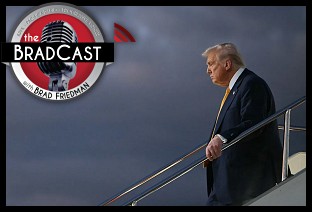 A Pretty Weak 'Strongman': 'BradCast' 10/30/25
A Pretty Weak 'Strongman': 'BradCast' 10/30/25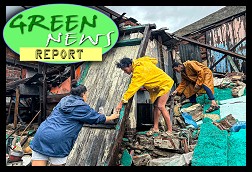 'Green News Report' 10/30/25
'Green News Report' 10/30/25
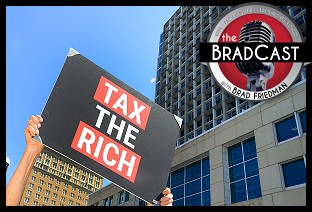 Proposal for 'First Politically Viable Wealth Tax' Takes Shape in CA: 'BradCast' 10/29/25
Proposal for 'First Politically Viable Wealth Tax' Takes Shape in CA: 'BradCast' 10/29/25 Monster Storm, Endless Wars, Gamed Elections:
Monster Storm, Endless Wars, Gamed Elections: 'Green News Report' 10/28/25
'Green News Report' 10/28/25 Let's Play 'Who Wants
Let's Play 'Who Wants Sunday 'Cartoonists Dilemma' Toons
Sunday 'Cartoonists Dilemma' Toons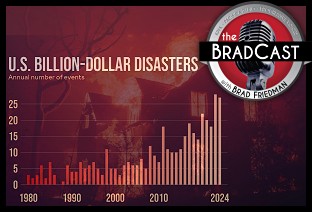 Exiled NOAA Scientists Resurrect Critical Disaster Database: 'BradCast' 10/23/25
Exiled NOAA Scientists Resurrect Critical Disaster Database: 'BradCast' 10/23/25  'Green News Report' 10/23/25
'Green News Report' 10/23/25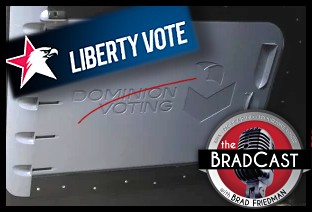 Trump-Allied GOP Partisan Buys Dominion Voting Systems: 'BradCast' 10/22/25
Trump-Allied GOP Partisan Buys Dominion Voting Systems: 'BradCast' 10/22/25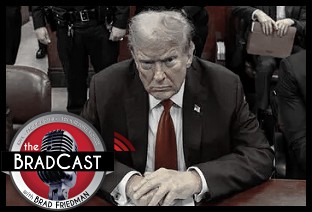 Trump, Republican Law(lessness) & (Dis)Order: 'BradCast' 10/21/25
Trump, Republican Law(lessness) & (Dis)Order: 'BradCast' 10/21/25 'Green News Report' 10/21/25
'Green News Report' 10/21/25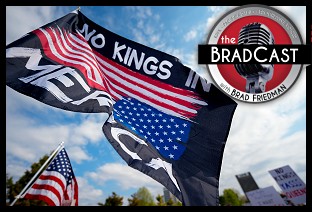 Celebrating 'No Kings': 'BradCast' 10/20/25
Celebrating 'No Kings': 'BradCast' 10/20/25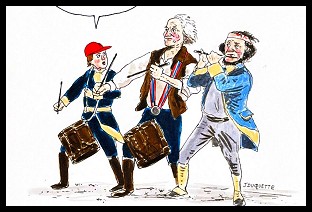 Sunday 'How It Started' Toons
Sunday 'How It Started' Toons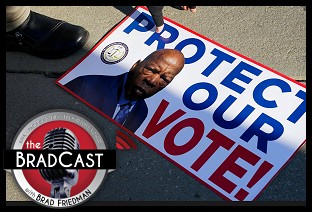 SCOTUS Repubs Appear Ready to Gut Rest of Voting Rights Act: 'BradCast' 10/16/25
SCOTUS Repubs Appear Ready to Gut Rest of Voting Rights Act: 'BradCast' 10/16/25 'Green News Report' 10/16/25
'Green News Report' 10/16/25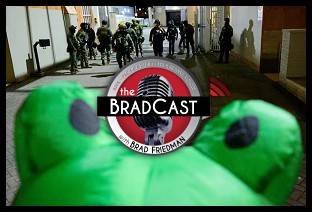 The 'Epstein Shutdown' and Other Autocratic Nightmares: 'BradCast' 10/15/25
The 'Epstein Shutdown' and Other Autocratic Nightmares: 'BradCast' 10/15/25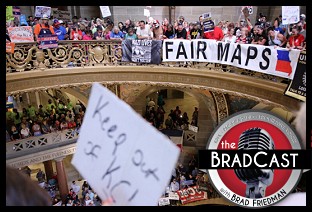 Group Vows to Block MO's GOP U.S. House Gerrymander: 'BradCast' 10/14/25
Group Vows to Block MO's GOP U.S. House Gerrymander: 'BradCast' 10/14/25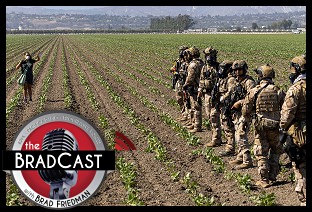 Trump Labor Dept. Warns Trump Policies Sparking Food Crisis: 'BradCast' 10/9/25
Trump Labor Dept. Warns Trump Policies Sparking Food Crisis: 'BradCast' 10/9/25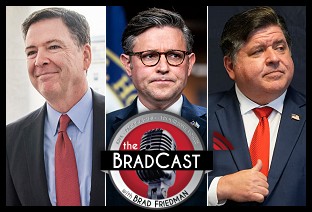 Trump's Losing Battles: 'BradCast' 10/8/25
Trump's Losing Battles: 'BradCast' 10/8/25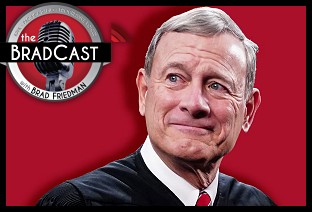 Trump, Roberts and His Stacked, Packed and Captured SCOTUS: 'BradCast' 10/7/25
Trump, Roberts and His Stacked, Packed and Captured SCOTUS: 'BradCast' 10/7/25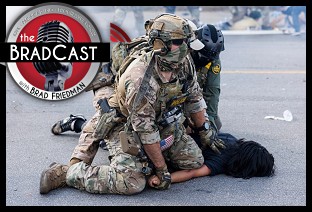 Trump Attempting His 'Invasion from Within': 'BradCast' 10/6/25
Trump Attempting His 'Invasion from Within': 'BradCast' 10/6/25 Biden Budget Expert: Mass Firings in Shutdown 'Illegal': 'BradCast' 10/2/25
Biden Budget Expert: Mass Firings in Shutdown 'Illegal': 'BradCast' 10/2/25 Why is DOJ Suing 'Blue' States for Their Voter Databases?: 'BradCast' 10/1/25
Why is DOJ Suing 'Blue' States for Their Voter Databases?: 'BradCast' 10/1/25
 VA GOP VOTER REG FRAUDSTER OFF HOOK
VA GOP VOTER REG FRAUDSTER OFF HOOK Criminal GOP Voter Registration Fraud Probe Expanding in VA
Criminal GOP Voter Registration Fraud Probe Expanding in VA DOJ PROBE SOUGHT AFTER VA ARREST
DOJ PROBE SOUGHT AFTER VA ARREST Arrest in VA: GOP Voter Reg Scandal Widens
Arrest in VA: GOP Voter Reg Scandal Widens ALL TOGETHER: ROVE, SPROUL, KOCHS, RNC
ALL TOGETHER: ROVE, SPROUL, KOCHS, RNC LATimes: RNC's 'Fired' Sproul Working for Repubs in 'as Many as 30 States'
LATimes: RNC's 'Fired' Sproul Working for Repubs in 'as Many as 30 States' 'Fired' Sproul Group 'Cloned', Still Working for Republicans in At Least 10 States
'Fired' Sproul Group 'Cloned', Still Working for Republicans in At Least 10 States FINALLY: FOX ON GOP REG FRAUD SCANDAL
FINALLY: FOX ON GOP REG FRAUD SCANDAL COLORADO FOLLOWS FLORIDA WITH GOP CRIMINAL INVESTIGATION
COLORADO FOLLOWS FLORIDA WITH GOP CRIMINAL INVESTIGATION CRIMINAL PROBE LAUNCHED INTO GOP VOTER REGISTRATION FRAUD SCANDAL IN FL
CRIMINAL PROBE LAUNCHED INTO GOP VOTER REGISTRATION FRAUD SCANDAL IN FL Brad Breaks PA Photo ID & GOP Registration Fraud Scandal News on Hartmann TV
Brad Breaks PA Photo ID & GOP Registration Fraud Scandal News on Hartmann TV  CAUGHT ON TAPE: COORDINATED NATIONWIDE GOP VOTER REG SCAM
CAUGHT ON TAPE: COORDINATED NATIONWIDE GOP VOTER REG SCAM CRIMINAL ELECTION FRAUD COMPLAINT FILED AGAINST GOP 'FRAUD' FIRM
CRIMINAL ELECTION FRAUD COMPLAINT FILED AGAINST GOP 'FRAUD' FIRM RICK SCOTT GETS ROLLED IN GOP REGISTRATION FRAUD SCANDAL
RICK SCOTT GETS ROLLED IN GOP REGISTRATION FRAUD SCANDAL VIDEO: Brad Breaks GOP Reg Fraud Scandal on Hartmann TV
VIDEO: Brad Breaks GOP Reg Fraud Scandal on Hartmann TV RNC FIRES NATIONAL VOTER REGISTRATION FIRM FOR FRAUD
RNC FIRES NATIONAL VOTER REGISTRATION FIRM FOR FRAUD EXCLUSIVE: Intvw w/ FL Official Who First Discovered GOP Reg Fraud
EXCLUSIVE: Intvw w/ FL Official Who First Discovered GOP Reg Fraud GOP REGISTRATION FRAUD FOUND IN FL
GOP REGISTRATION FRAUD FOUND IN FL

































